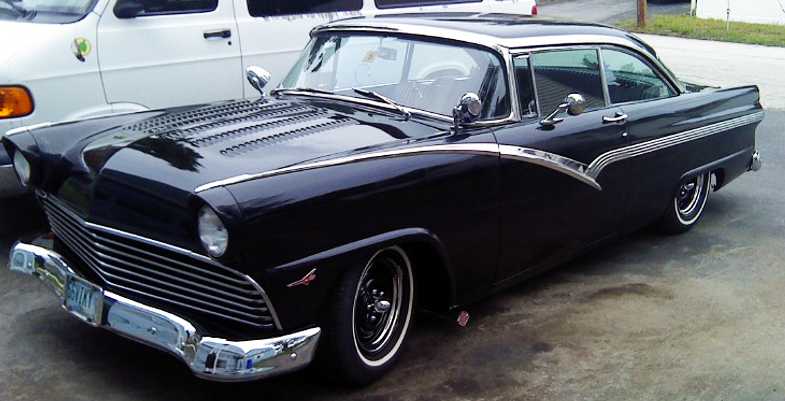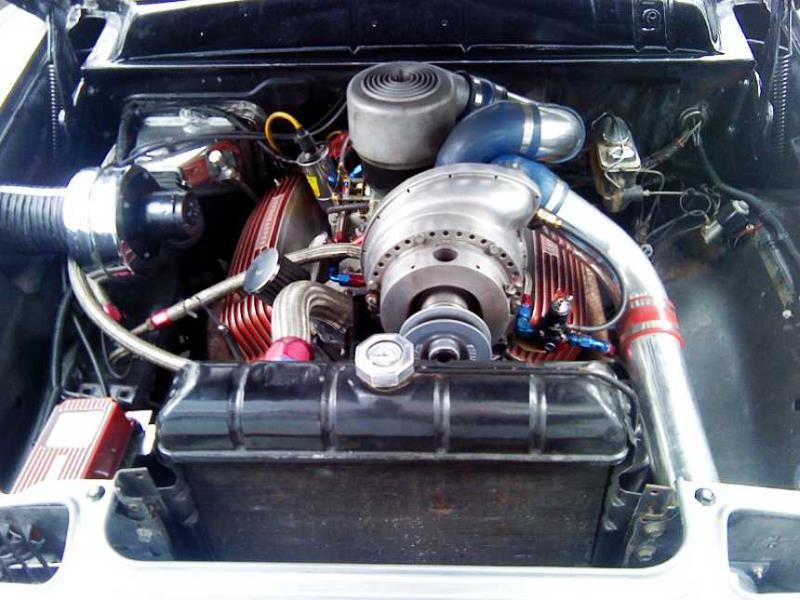|
Author
|
Message
|
|
Outlaw56
|
|
|
Group: Forum Members
Last Active: 2 Years Ago
Posts: 435,
Visits: 26.8K
|
I tried to attache pictures but I keep getting a pop up that doing that would exceed my limits, so I will try without photo. In the center of the intake under the carberator (side to side of engine), one side has a small muchroom shaped vent. It just pulls off. The opposite side has a little hole, but nothing in it.
I am in the process of eliminating road draft tube and going with pvc valve in the back of the valley pan to a block that fits between the carb and intake. I am also upgrading the distributer to a newer version (C3TF 121127 3ED Ford). I am going to install a new carberator but do not know if I will go with manual or electric choke, most likely electric.
My question is what is the mushroom vent for (Driver side) and the open hole (Passenger side)?
Just want know before I paint up the intake.
Is there problem with the software posting pictures or do I have to downsize them to post from my compter?
Darrell Howard Whitefish, MT Outlaw 56 Ford F-100's
|
|
|
|
|
NoShortcuts
|
|
|
Group: Forum Members
Last Active: 2 Years Ago
Posts: 1.4K,
Visits: 179.6K
|
Outlaw56 (4/20/2014)
In the center of the intake under the carburetor (side to side of engine), one side has a small mushroom shaped vent. It just pulls off. The opposite side has a little hole, but nothing in it.
My question is what is the mushroom vent for (Driver side) and the open hole (Passenger side)? _______________________ A steel tube runs through the inside of the intake manifold. The steel tube passes through the exhaust passageway that runs beneath the carburetor. The intake manifold exhaust passageway connects the exhaust by-pass port from the passenger side cylinder head to the driver's side cylinder head exhaust by-pass port.
The air intake for this steel tube running through the intake manifold is at the mushroom shaped fitting on the driver's side. A brass elbow originally fit into the exit hole for the steel tube on the passenger side of the intake manifold. Another steel tube with an insulating sleeve over it fit into the brass elbow and provided heated air to the bi-metallic spring inside the choke stove with the black phenolic cover on the passenger side of the original Holley 4150, Autolite 4100, or Carter AFB carburetor. The hot air from the choke heat tube made the bi-metallic spring in the heat stove expand to move the choke linkage opening the carburetor choke plates.
____________________________
IF you are going to run a carburetor with a manual choke or an electric choke, consider plugging the openings for this heat tube that runs from one side of the intake manifold to the other. A hex head SS self tapping screw would be sufficient and neatly seal it up. The reason to plug the holes is that eventually the steel tube will rust through and you will have an exhaust leak from the intake manifold on one if not both sides under your carburetor.
Hope this helps.  NoShortcuts
NoShortcuts
a.k.a. Charlie Brown
near Syracuse, New York
|
|
|
|
|
Outlaw56
|
|
|
Group: Forum Members
Last Active: 2 Years Ago
Posts: 435,
Visits: 26.8K
|
Awesome, I had no idea what to do. I took a die grinder to all the casting imperfections and ground them all smooth. Got her cleaned up and ready for paint. Is there anything else I should do? Im planning on using the rubber gaskets without any sealer so I can check the oil to the rocker arms once I start it up.
Darrell Howard Whitefish, MT Outlaw 56 Ford F-100's
|
|
|
|
|
NoShortcuts
|
|
|
Group: Forum Members
Last Active: 2 Years Ago
Posts: 1.4K,
Visits: 179.6K
|
The following has been borrowed from the C.T.C.I. website at https://www.ctci.org/ under the section 'Gil's Garage __________________________
Paint burn off at the intake center exhaust cross-over has always been a problem on Ford Y block engines. This can be held to a minimum if heavy duty 292 truck intake gaskets are used. The 292 heavy duty four barrel truck intake gaskets are no longer available from FoMoCo, but they are available after market. They can be purchase at most automotive parts stores that sell Victor gaskets, P/N MS15116. The truck intake manifold gaskets have smaller holes that restrict heat transfer through the center of the intake manifold.
The use of the truck gaskets coupled with good quality high temp engine paint can significantly reduce paint burn-off. Gil Baumgartner, Authenticity Chairman, Classic Thunderbird Club International __________________________ Hmmmm... I tried to post a picture of the truck intake manifold gaskets, but it's not showing....

Hope this helps. 
a.k.a. Charlie Brown
near Syracuse, New York
|
|
|
|
|
Outlaw56
|
|
|
Group: Forum Members
Last Active: 2 Years Ago
Posts: 435,
Visits: 26.8K
|
I checked out those gaskets on the site you posted Charlie. Ive also heard you can put a thin piece of metal over both sides of that center carb port that goes under the carb. I will take the part number and check local parts store. Sounds like a good way to go and I really dont need that choke tube heating up for my application (manual or electric choke). I also see Gil cautions not getting the intake gaskets installed on the wrong side. Guess I better figure that out before I install them. This project is one of three. Shes a F-250 long box flatbed with duallies. 272 that I will bore to 292 for a winter project. Meanwhile I have tore her apart, painted the frame and replaced all components in the axels. New brake lines. New cab corners, doing body work on cab and will remove all rust and paint stock color medow green with the off white trim. Once she is back together I want to drive her, but will ultimately get the engine rebuilt. I have swapped in this intake, an newer distributer and she will get a four barrell.
Meanwhile, I have another 56 Ford f-100 that has a 292 Im working on, All tore down and in the process of being reinstalled. Then I have an F-100 stripped and in pieces with a brand new 351 balanced and blueprinted with March Pulley System ready to drop in.
I fell in love with a 56 Ford F-600 Dump Truck that is headed for the crusher. I just can save them all. But its been fun trying. I do all the work myself except the machine shop engine work, so the costs are kept down but still significant. Thanks for your help.
Darrell Howard Whitefish, MT Outlaw 56 Ford F-100's
|
|
|
|
|
Outlaw56
|
|
|
Group: Forum Members
Last Active: 2 Years Ago
Posts: 435,
Visits: 26.8K
|
[quote]Outlaw56 (4/20/2014)
I tried to attache pictures but I keep getting a pop up that doing that would exceed my limits, so I will try without photo. In the center of the intake under the carberator (side to side of engine), one side has a small muchroom shaped vent. It just pulls off. The opposite side has a little hole, but nothing in it.
I stand corrected in my initial post. The drivers side mushroom vent cap does not exit the exhaust port on the drivers side, its between that exhaust port and the rear port (firewall end) of the manifold. I dont think this changes anything, but it was not explained correctly in the first post. So, that being said, if the holes can be plugged with a stainless self threading bolt, the hole on the passenger side is just a hole. The driver side has a little piece of the steel pipe exiting the manifold which attaches to the mushroom vent. If your going to plug that side, do you cut the pipe off flush with the manifold, then plug it?
Darrell Howard Whitefish, MT Outlaw 56 Ford F-100's
|
|
|
|
|
paul2748
|
|
|
Group: Forum Members
Last Active: Yesterday
Posts: 3.6K,
Visits: 497.7K
|
just go with a smaller self tapping screw on the drivers side. Actually, none of the pipe that is in the manifold is supposed to stick out as far as I know. The passenger side probably has the pipe in a little bit so you cannot see it. When I replaced the pipe in my manifold, I think it was the exact length (or a little bit longer) of the manifold so it was about even on each side.
54 Victoria 312; 48 Ford Conv 302, 56 Bird 312
Forever Ford
Midland Park, NJ
|
|
|
|
|
Outlaw56
|
|
|
Group: Forum Members
Last Active: 2 Years Ago
Posts: 435,
Visits: 26.8K
|
Thanks Paul, I might try tapping it just to see if it might move far enough to lossen up and be extracted. Otherwise, just use appropriate size on each side. Thanks.
Darrell Howard Whitefish, MT Outlaw 56 Ford F-100's
|
|
|
|
|
MoonShadow
|
|
|
Group: Forum Members
Last Active: Yesterday
Posts: 4.6K,
Visits: 38.4K
|
Get a bolt that fits the hole, select a tube or socket bigger than the bung, put washer between bolt and socket then screw in into the bung. Continue to screw down and the bolt should pull the bung out! Chuck
Y's guys rule!
Looking for McCullouch VS57 brackets and parts. Also looking for 28 Chrysler series 72 parts. And early Hemi parts.
 
MoonShadow, 292 w/McCulloch, 28 Chrysler Roadster, 354 Hemi)
Manchester, New Hampshire
|
|
|
|
|
NoShortcuts
|
|
|
Group: Forum Members
Last Active: 2 Years Ago
Posts: 1.4K,
Visits: 179.6K
|
You can take the tube out if you want to, Darrell, but I don't see the need. Screwing a self tapping screw into the steel tube keeps the original bore intact should you ever have a need to use it for a replacement tube. The holes for the steel tube are two different diameter on the driver's side and the passenger side. -You may need two different size self tapping screws.
Like Paul, I believe that the steel tube was intended to be flush with the openings on the two sides of the intake manifold. Being a ~57 year old component, the steel tube in your manifold may have been changed more than once.
__________________
Yes, a piece of sheet metal closing off the opening in the intake manifold gasket on each side will do the job. You don't have to have the HD truck style intake manifold gaskets. Personally, I would like to use a SS piece for corrosion or oxidation reasons. 30 gauge SS would be fine. Yeah, that's thin! Copper or brass would work, too. Mild steel, galvanized steel, or tin plated steel will all rust in short order I would expect. __________________ The original FoMoCo y-block 4 bbl. intake manifold came with a spacer under the carburetor. Many of these were a phenolic plastic. I've got some that were aluminum, but I'm not sure what year vehicle or application they're from.
I would be sure to use a phenolic spacer between the carb and the intake manifold for heat isolation purposes.
Regards,
a.k.a. Charlie Brown
near Syracuse, New York
|
|
|
|